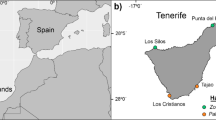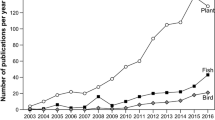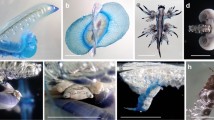Abstract
The feeding ecology and trophic level of the banded guitarfish, Zapteryx exasperata, from the Gulf of California, were assessed using stable isotope analysis (SIA) of carbon and nitrogen in muscle samples, and stomach contents analysis (SCA). Males and females showed similar diet preferences with a high diet overlap (Cλ = 0.99) and similar values of δ13C and δ15N (ANOVA, F = 0.0 p = 0.94 for δ13C; F = 0.1 p = 0.78 for δ15N). The main prey groups found were demersal fishes dominated by the daisy midshipman, Porichthys margaritatus, (>90%IRI), however, pelagic fishes were also found (Engraulis mordax 2%IRI). An ontogenetic diet shift was found, indicated by the importance of crustaceans in the juvenile diet and the significant isotopic differences between juveniles and adults (δ13C, ANOVA, F = 13.3 p = 0.0004 and δ15N, ANOVA, F = 4.7 p = 0.03). An overall trend of increase in δ15N values with increasing body length (F = 8.15 p = 0.005) was observed. The mean trophic level estimated in this work by the two methods was ~4.1, indicating that this species is a top predator in the Gulf of California. Zapteryx exasperata is a specialist feeder (Bi = 0.11, H’ = 2.32), consuming mainly benthic fishes in coastal areas of the Gulf of California. The importance of this species in the benthic ecosystem equilibrium as a top predator is an important point to keep in mind when developing future management plans of the batoid fishery in the Gulf of California.







Similar content being viewed by others
References
Abdel-Aziz SH, Khalil AN, Abdel-Maguid SA (1993) Food and feeding habits of the common guitarfish, Rhinobatos rhinobatos in Egyptian Mediterranean waters. Indian J Mar Sci 22:287–290
Adams J (2004) Foraging ecology and reproductive biology of Cassin’s Auklet (Ptychoramphus aleuticus) in the California Channel Islands. M.Sc.Thesis, Moss Landing Marine Laboratories, California State University, San Francisco, p 119
Allen GR, Robertson DR (1994) Peces del Pacífico Oriental Tropical. CONABIO, Agrupación Sierra Madre y CEMEX, México
Bizzarro JJ, Robinson HJ, Rinewalt CS, Ebert DA (2007) Comparative feeding ecology of four sympatric skate species off central California, USA. Environ Biol Fishes 80(1–2):197–220
Blanco-Parra MP, Márquez-Farias JF, Galván-Magaña F (2009a) Fishery and morphometric relationships of the banded guitarfish, Zapteryx exasperata (Elasmobranchii, Rhinobatidae), from the Gulf of California, Mexico. Panam J Aquat Sci 4(4):456–465
Blanco-Parra MP, Márquez-Farias JF, Galván-Magaña F (2009b) Reproductive biology of the banded guitarfish, Zapteryx exasperata, from the Gulf of California, Mexico. J Mar Biol Assoc UK 89:1655–1662
Bornatowski H, Robert MC, Costa L (2010) Feeding of guitarfish Rhinobatos percellens (Walbaum, 1972)(Elasmobranchii, Rhinobatidae), the target of artisanal fishery in Southern Brazil. Bras J Oceanogr 58:45–52
Bowman RE (1986) Effect of regurgitation on stomach content data of marine fishes. Environ Biol Fishes 16(1):171–181
Brusca RC (1980) Common intertidal invertebrates of the Gulf of California. University of Arizona Press,
Clarke MR (1986) A handbook for the identification of cephalopod beaks. Clarendon, Oxford
Clarke KR, Warwick RM (1994) Similarity-based testing for community pattern: the two-way layout with no replication. Mar Biol 118(1):167–176
Clementz MT, Koch PL (2001) Differentiating aquatic mammal habitat and foraging ecology with stable isotopes in tooth enamel. Oecologia 129:461–472
Clothier CR (1950) A key to some Southern California fishes based on vertebral characters. Fish Bull 79:1–83
Collins AB, Heupel MR, Hueter RE, Motta PJ (2007) Hard prey specialists or opportunistic generalists? An examination of the diet of the cownose ray, Rhinoptera bonasus. Mar Freshw Res 58(1):135–144
Compagno LJV (1990) Alternative life-history styles of cartilaginous fishes in time and space. Environ Biol Fishes 28(1):33–75
Cortés E (1997) A critical review of methods of studying fish feeding based on analysis of stomach contents: application to elasmobranch fishes. Can J Fish Aquat Sci 54:726–738
Cortés E (1999) Standardized diet compositions and trophic levels of sharks. ICES J Mar Sci 56(5):707–717
DeNiro MJ, Epstein S (1978) Influence of diet on the distribution of carbon isotopes in animals. Geochim Cosmochim Acta 42(5):495–506
Ebert DA (2003) Sharks, rays and chimaeras of California, vol 71. California natural history guides. University of California, Los Angeles
Ebert DA, Bizzarro JJ (2007) Standardized diet compositions and trophic levels of skates (Chondrichthyes: Rajiformes: Rajoidei). Environ Biol Fishes 80(2):221–237
Ebert DA, Cowley PD (2003) Diet, feeding behaviour and habitat utilisation of the blue stingray Dasyatis chrysonota (Smith, 1828) in South African waters. Mar Freshw Res 54(8):957–965
Ellis JR, Pawson MG, Shackley SE (1996) The comparative feeding ecology of six species of sharks and four species of ray (Elasmobranchii) in the North-East Atlantic. J Mar Biol Assoc UK 76:89–106
Escobar-Sánchez O, Galván-Magaña F, Abitia-Cárdenas LA (2011) Trophic Level and Isotopic Composition of δ13C and δ15N of Pacific Angel Shark, Squatina californica (Ayres, 1859), in the Southern Gulf of California, Mexico. J Fish Aquat Sci 6(2):141–150
Estrada JA, Rice AN, Lutcavage ME, Skomall GB (2003) Predicting trophic position in sharks of the north-west Atlantic Ocean using stable isotope analysis. J Mar Biol Assoc UK 83(6):1347–1350
Estrada JA, Rice AN, Natanson LJ, Skomal GB (2006) Use of isotopic analysis of vertebrae in reconstructing ontogenetic feeding ecology in white sharks. Ecology 87(4):829–834
Ferry LA, Cailliet GM (1996) Sample size sufficiency and data analysis: are we characterizing and comparing diet properly? In: MacKinlay D, Shearer K (eds) Feeding ecology and nutrition in fish: proceedings of the symposium on the feeding ecology and nutrition in fish. International Congress on the Biology of Fishes, San Francisco, pp 71–80
Froese R, Pauly D (eds) (2011) FishBase. World Wide Web electronic publication.www.fishbase.org, version (02/2011).
Fisher W, Krupp F, Schneider W, Sommer C, Carpeter K, Niem V (1995) Pacífico Centro-Oriental; Guía FAO para la identificación de especies para los fines de pesca, vol 2. FAO, Roma
Fisk AT, Tittlemier SA, Pranschke JL, Norstrom RJ (2002) Using anthropogenic contaminants and stable isotopes to assess the feeding ecology of greenland sharks. Ecology 83(8):2162–2172
France RL (1995) C-13 Enrichment in benthic compared to planktonic algae—foodweb Implications. Mar Ecol Prog Ser 124(1–3):307–312
Fry B, Parker PL (1979) Animal diet in texas seagrass meadows—Delta-C-13 evidence for the importance of benthic plants. Estuar Coast Mar Sci 8(6):499–509
Godinez-Dominguez E, Aguilar-Palomino B, Gonzalez-Sanson G (2001) Abundance variation of Porichthys margaritatus (Pisces: Batrachoididae) throughout thermic and bathymetric gradients in the central Mexican Pacific. Rev Biol Trop 49(2):643–646
Goitein R, Torres FS, Signorini CE (1998) Morphological aspects related to feeding of two marine skates Narcine brasiliensis Olfers and Rhinobatos horkelli Müller & Henle. Acta Scientiarum 20(2):165–169
Gray AE, Mulligan TJ, Hannah RW (1997) Food habits, occurrence, and population structure of the bat ray, Myliobatis californica, in Humboldt Bay, California. Environ Biol Fishes 49(2):227–238
Harris SA, Bennett BA, Branch GM (1988) An assessment of the role of the sand shark Rhinobatos annulatus as a predator in Langebaan Lagoon. S Afr J Mar Sci/Suid-Afrikaanse Tydskrif vir Seewetenskap 7:153–159
Hobson KA, Welch HE (1992) Determination of trophic relationships within a high arctic marine food web using Delta-C-13 and Delta-N-15 analysis. Mar Ecol Prog Ser 84(1):9–18
Ismen A, Yigin C, Ismen P (2007) Age, growth, reproductive biology and feed of the common guitarfish (Rhinobatos rhinobatos Linnaeus, 1758) in Iskenderun Bay, the Eastern Mediterranean Sea. Fish Res 84(2):263–269
Jennings S, Pinnegar JK, Polunin NVC, Warr KJ (2002) Linking size-based and trophic analyses of benthic community structure. Mar Ecol Prog Ser 226:77–85
Kerr L, Andrews A, Cailliet G, Brown T, Coale K (2006) Investigations of 14 C, 13 C, and 15 N in vertebrae of white shark (Carcharodon carcharias) from the eastern North Pacific Ocean. Environ Biol Fishes 77(3–4):337–353
Krebs CJ (1999) Ecological methodology, 2nd edn. Benjamin-Cummings, Menlo Park
Kyne PM, Bennett MB (2002) Diet of the eastern shovelnose ray, Aptychotrema rostrata (Shaw & Nodder, 1794), from Moreton Bay, Queensland, Australia. Mar Freshw Res 53(3):679–686. doi:10.1071/mf01040
Link JS, Garrison LP, Almeida FP (2002) Ecological interactions between elasmobranchs and groundfish species on the northeastern US continental shelf. I. Evaluating predation. N Am J Fish Manage 22(2):550–562
MacNeil MA, Drouillard KG, Fisk AT (2006) Variable uptake and elimination of stable nitrogen isotopes between tissues in fish. Can J Fish Aquat Sci 63(2):345–353
Márquez-Farías JF, Blanco-Parra MP (2006) Rayas. In: Cuellar PJ, Cadena CO (eds) Sustentabilidad y Pesca Responsable en México, Evaluación y Manejo. Instituto Nacional de la Pesca, México, pp 303–319
Marshall LJ, White WT, Potter IC (2007) Reproductive biology and diet of the southern fiddler ray, Trygonorrhina fasciata (Batoidea: Rhinobatidae), an important trawl bycatch species. Mar Freshw Res 58(1):104–115. doi:10.1071/mf05165
Miller DJ, Lea RN (1972) Guide to the coastal marine fishes of California. Calif Fish Game, Fish Bull 157:1–249
Morato T, Solà E, Grós MP (2003) Diets of thornback ray (Raja clavata) and tope shark (Galeorhinus galeus) in the bottom longline fishery of the Azores, Northeastern Atlantic. Fish Bull 101:590–602
Navia AF, Mejía-Falla PA, Giraldo A (2007) Feeding ecology of elasmobranch fishes in coastal waters of the Colombian Eastern Tropical Pacific. BMC Ecol 7(1):8
Niño-Torres CA, Gallo-Reynoso JP, Galvan-Magana F, Escobar-Briones E, Macko SA (2006) Isotopic analysis of delta C-13, delta N-15, and delta S-34 “a feeding tale” in teeth of the longbeaked common dolphin, Delphinus capensis. Mar Mamm Sci 22(4):831–846
Pinkas LM, Oliphant S, Iverson ILK (1971) Food habits of albacore, bluefin tuna, and bonito in California waters. Calif Fish Game 152:1–105
Post DM (2002) Using stable isotopes to estimate trophic position: models, methods, and assumptions. Ecology 83(3):703–718
Rinewalt CS, Ebert DA, Cailliet GM (2007) Food habits of the sandpaper skate, Bathyraja kincaidii (Garman, 1908) off central California: seasonal variation in diet linked to oceanographic conditions. Environ Biol Fish 80(2–3):147–163
Robinson HJ, Cailliet GM, Ebert DA (2007) Food habits of the longnose skate, Raja rhina (Jordan and Gilbert, 1880), in central California waters. Environ Biol Fishes 80(1–2):221–237
Rossouw GJ (1983) The importance of non-teleost fishes (Elasmobranchs) in the surf zone with special reference to Rhinobatos annulatus. In: McLachlan A, Erasmus T (eds) Sandy beaches as ecosystems. Dr W. Junk, The Hague, p 749
Sims D (2005) Differences in habitat selection and reproductive strategies of male and female sharks. In: Ruckstuhl K, Neuhaus P (eds) Sexual segregation in vertebrates: ecology of the two sexes. Cambridge University Press, New York, pp 127–147
Sims DW, Andrews PL, Young JZ (2000) Stomach rinsing in rays. Nature :566–566
Skjæraasen JE, Bergstad OA (2000) Distribution and feeding ecology of Raja radiata in the northeastern North Sea and Skagerrak (Norwegian Deep). ICES J Mar Sci 57(4):1249
Smale MJ, Cowley PD (1992) The feeding ecology of skates (Batoidea: Rajidae) off the Cape south coast, South Africa. S Afr J Mar Sci 12(1):823–834
Talent LG (1982) Food habits of the gray smoothhound, Mustelus californicus, the brown smoothhound, Mustelus henlei, the shovelnose guitarfish, Rhinobatos productus and the bat ray, Myliobatis californica, in Elkhorn Slough, California. Calif Fish Game 68(4):224–234
Thomson DA, Findley LT, Kerstitch AN (2000) Reef fishes of the Sea of Cortez. The Rocky-Shore Fishes of the Gulf of California. The University of Texas Press, Austin
Walker JL, Potter CW, Macko SA (1999) The diets of modern and historic bottlenose dolphin populations reflected through stable isotopes. Mar Mamm Sci 15(2):335–350
White WT, Platell ME, Potter IC (2004) Comparisons between the diets of four abundant species of elasmobranchs in a subtropical embayment: implications for resource partitioning. Mar Biol 144(3):439–448
Acknowledgements
Special thanks to the fishermen from Estero del Soldado, Sonora, for allowing us to take samples, and to personnel from the aquatic chemistry laboratory from the Centro Interdisciplinario de Ciencias Marinas (CICIMAR-IPN) for support in the stable isotope analysis. This research was funded in part by the Instituto Nacional de Pesca, Project “Pesca Ribereña” CRIP-Guaymas and Centro Interdisciplinario de Ciencias Marinas Project “Ecology of elasmobranchs in Baja California Sur”. MPBP would like to thank the Dirección General de Estudios de Posgrado, Universidad Nacional Autónoma de México for her PhD scholarship. FGM thanks the Instituto Politecnico Nacional (COFAA and EDI fellowships). Special thanks are given to L. Sampson and K.D. Eaton for the English review of this manuscript. All activities presented in this work were conducted in compliance with Mexican laws and regulations.
Author information
Authors and Affiliations
Corresponding author
Rights and permissions
About this article
Cite this article
Blanco-Parra, MdP., Galván-Magaña, F., Márquez-Farías, J.F. et al. Feeding ecology and trophic level of the banded guitarfish, Zapteryx exasperata, inferred from stable isotopes and stomach contents analysis. Environ Biol Fish 95, 65–77 (2012). https://doi.org/10.1007/s10641-011-9862-7
Received:
Accepted:
Published:
Issue Date:
DOI: https://doi.org/10.1007/s10641-011-9862-7




